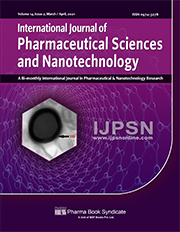Synthesis and Antimicrobial Screening of Some Novel 5-Substituted-1,10b-dihydroimidazole[1,2-c]quinazoline Derivatives
DOI:
https://doi.org/10.37285/ijpsn.2021.14.2.6Abstract
The emergence of multidrug microbial resistance is the main challenges that the modern scientists have so far been facing in the recent era. In this respect, new series of drug classes having potential to give antimicrobial effect have been synthesized. A new series of 5- substituted-1,10 b-dihydroimidazole[1,2-c]quinazoline derivatives 8a-e have been synthesized and screened for antibacterial activity and antifungal activity. Synthesized derivatives were characterized by IR, MASS and 1H-NMR spectroscopy. Synthesized compounds show good activity, which was comparable to the standard drug and it can be useful for the further clinical study. Antibacterial activity was evaluated against four different pathogenic bacterial strains like Staphylococcus aureus, Enterococcus faecalis, Escherichia coli and Pseudo-monas aeruginosa. Among the screened compounds, 8e show good antibacterial activity against Staphylococcus aureus and Escherichia coli with MIC of 50 and 100 μg/ml respectively. Antifungal activity was evaluated against two strains of fungi. Among the synthesized derivates, compound 8c was emerged out as the potent antifungal compound against Candida albicans and Aspergillus niger with MIC of 25 μg/ml and 75μg/ml respectively. Compound 8e also shows good antifungal activity with MIC of 50 μg/ml against both Candida albicans and Aspergillus niger. The overall results of this study indicated that synthesized quinazoline derivatives had the potential to act as an antibacterial and antifungal agent, hence further investigation is warranted.
Downloads
Metrics
Keywords:
Quinazolines, 5-substituted-1, 10b-dihydroimidazoles, Antibacterial, AntifungalDownloads
Published
How to Cite
Issue
Section
References
Alagarsamy V, Murugananthan G and Venkateshperumal R (2003). Synthesis, analgesic, antiinflammatory and antibacterial activities of some novel 2-methyl-3-substituted quinazolin-4- (3H)-ones. Biol Pharm Bull 26(12): 1711-1714.
Apfel C, Banner DW et al (2001). 2-(2-Oxo-1,4-dihydro-2H-quinazoli- 3-yl)- and 2-(2,2-dioxo-1,4-dihydro-2H-2lambda 6-benzo [1,2,6] thiadiazin-3-yl)-N-hydroxy-actamidesas potent and selective peptide deformylase inhibitors. J Med Chem 44: 1847-1852.
Bedi PMS and Kumar MMP (2004). Synthesis and biological activity of novel antibacterial quinazolines. Bioorg Med Chem Lett 14: 5211-5213.
Bhatnagar A, Sharma PK and Kumar N (2011). A review on imidazole: Their chemistry and pharmacological potentials. Int J Pharm Tech Res 3: 268-82.
Chenard BL, Welch WM et al (2001). Quinazolin-4-1α-amino-3- hydroxy-5-methyl-4-isoxazolepropionic acid (AMPA) receptor antagonists: Structure-activity relationship of the C-2 side chain tether. J Med Chem 44: 1710-1717.
Chandrika PM, Yakaiah T, Narsiah B and Sridhar V (2009). Synthesis leading to novel 2,4,6-trisubstituted quinazoline derivatives, their antibacterial and cytotoxic activity against THP-1, HL-60 and A375 cell lines. Ind J Chem 48(B): 840-847.
Ellsworth EL, Tran TP et al (2006). 3-Aminoquinazolinediones as a new class of antibacterial agents demonstrating excellent antibacterial activity against wild-type and multidrug resistant organisms. J Med Chem 49(20): 6435-6438.
Farzanabi S, Samundeeswari Set et al (2018). Synthesis of 2,3‐dihydro flavone coumarins as a class of potent antifungal and anti-inflammatory agents. Chemistry Select 3(12): 3451- 3458.
Guang-Fang X, Bao-An S et al (2007). Synthesis and antifungal activity of novel S-substituted-6-fluoro-4-alkyl(aryl) thioquina- zoline derivatives. Bioorg Med Chem 15: 3768-3774.
Gursoy A and Ilhan N(1995). Synthesis and antimicrobial evaluation of new quinazoline derivatives. Farmaco 50: 559-663.
Ibrahim SS, Halim AMA, Gabr Y, EiS, Fawy Ed and Rahiman RMA (1998). Synthesis and biological activities of some new fully fused quinazoline derivatives. Ind J Chem 37(B):62-67.
Jalil AR, Al-Harthy T et al (2016). Design, synthesis and cytotoxicity of 5-fluoro-2-methyl-6-(4-aryl-piperazin-1-yl) benzoxazoles. Molecules 21:1-11.
Jantova S and Spirkova K (1999). Antibacterial effect of some substituted tricyclic quinazolines and their synthetic precursor. Folia microbial 144:187-190.
Jantova S, Ovadekova R, Letasiova S, Spirkova K and Stankovsky S (2005). Antimicrobial activity of some substituted triazolo- quinazolines. Folia Microbiol 50: 90-94.
Jiang JB, Hesson DP et al (1990). Synthesis and biological evaluation of 2-styrylquinazolin-4(3H)-ones, a new class of antimitotic anticancer agents which inhibit tubulin polymerization. J Med Chem 33: 1721-1728.
Kurban S, Deniz NG et al (2019). Synthesis, antimicrobial properties and inhibition of catalase activity of 1,4-naphtho- and benzoquinone derivatives containing n-, s-, o-substituted. Heteroat Chem 2019:1-12.
Mahlo SM, Chauke HR, Gaw LR and Eloff J (2016). Antioxidant and antifungal activity of selected medicinal plant extracts against phytopathogenic fungi. Afr J Tradit Complement Altern Med 13(4): 216-22.
Ohno A (2004). Antimicrobial agents and drug-resistance mechanism. Infect Control 13(10):1012-1017.
Raffa D, Daidone G et al (1999). Synthesis of new 3-(3-phenyl- isoxazo-5-yl) or 3-[(3-phenyl-isoxazol-5-yl)-amino]substituted- 4(3H)quinazolinone derivatives with antineoplastic activity. Pharmazie 54: 251-254.
Shalini K, Sharma PK and Kumar N (2010). Imidazole and its biological activities: A review. Der Chem Sin 1: 36-47.
Tejchman W, Glowniak IK, Malm A, Zylewski M and Suder P (2017). Antibacterial properties of 5-substituted derivatives of rhodanine-3-carboxyalkyl acids. Med Chem Res 6(6):1316-24.
Tobe M, Isobe Y et al (2003). Structure-activity relationships of 6- fluoroquinazolines: dual-acting compounds with inhibitory activities toward both TNF alpha production and T cell proliferation. Bioorg Med Chem 11: 609-616.
Tran TP, Ellsworth EL et al (2004). Synthesis and structural- activity relationships of 3-hydroxyquinazoline-2,4-dione antibacterial agents. Bioorg Med Chem Lett 14(17): 4405-4409.
Tsemeugne J, Fondjo ES et al (2018). Synthesis, characterization and antimicrobial activityof a novel trisazo dye from 3-amino-4h- thieno[3,4-c][1]benzopyran-4-one. Int J Med Chem 2018:1-8.
Vega S, Dowzicky MJ (2017). Antimicrobial susceptibility among gram-positive and gram-negative organisms collected from the Latin American region between 2004 and 2015 as part of the tigecycline evaluation and surveillance trial. Ann Clin Microbiol Antimicrob 16(1): 50-65.
Vijayakumar B, Prasanthi P et al (2013). Quinazoline derivatives and pharmacological activities: A review. Int J Med Chem Anal 3: 10-21.
Yang YT, Zhu JF, Liao G, Xu HJ and Yu B (2018). The development of biologically important spirooxindoles as new antimicrobial agents. Curr Med Chem 25(19): 2233-2244.






